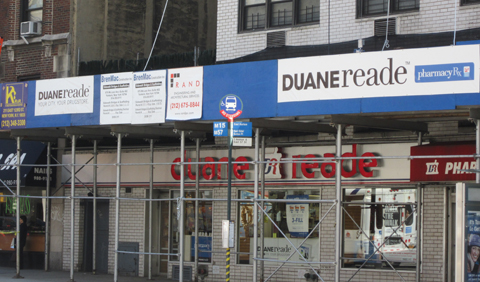As mandated by New York City Building Code, the Department of Buildings requires buildings with unsafe exterior conditions to protect people from falling masonry and debris. That protection is typically a sidewalk shed.
As previously discussed in RAND's Better Buildings Blog, sidewalk sheds seem to be everywhere you turn in the city—currently there are approximately 8,500 by the DOB's count. Many of the sheds are in place because the buildings are undergoing repairs following the latest Local Law 11/98 inspection cycle, now officially called the Facade Inspection & Safety Program (FISP).

Owners of buildings with unsafe conditions who remove sidewalk sheds before the DOB accepts the facade inspection report face violations and fines.
As necessary as sidewalk sheds are to public safety, the drab plywood-and-steel constructions are widely unloved. Throughout the city the eyesores are a common cause of complaints among building residents, pedestrians, store owners, and anyone forced to navigate under or around them. Plus, they seem to stay up forever. So when a sidewalk shed finally comes down it should be a reason to celebrate, right?
Well, not always.
In an attempt to address resident and commercial tenant complaints, and end the monthly rental fee for keeping a sidewalk shed in place, some owners are removing the sheds prematurely, i.e., before the DOB has given them the green light to do so.
After a building's unsafe conditions are corrected, the owner must file an amended FISP report with the DOB. The shed cannot be removed, however, until either one of two things happen:
- The DOB accepts the amended FISP report, upgrading the building's status from "Unsafe" to either "Safe" or "Safe with a Repair and Maintenance Program" (SWARMP).
- A DOB inspector visits the property and agrees no unsafe conditions remain.
Removing the sidewalk shed before either of one of these conditions is met can result in an $800 fine, which in and of itself is not much of a concern since the added monthly fee for sidewalk sheds typical exceeds that amount. More importantly, the DOB can reject an amended facade inspection report for any number of reasons.
If the shed has already been taken down and a DOB inspector subsequently determines there are still unsafe conditions at the building, the shed will have to be reinstalled. Since it costs significantly more to install a shed than pay the shed's monthly rental, it is much more cost effective to keep the shed up until the DOB officially accepts the amended report.
Even if the building is undergoing SWARMP repairs, owners should be careful not to jump the gun by removing the shed after filing the FISP report. Although the Project Engineer/Architect may have classified some building conditions as SWARMP, a DOB inspector may deem those same conditions unsafe, requiring the shed to stay in place until the conditions are corrected.
Yes, it's a relief when one of those dark, dreary sheds finally comes down, clearing the way for passersby and uncovering the windows and storefronts hidden underneath for months or even years. But as annoying as they may be, sidewalk sheds must remain in place until the DOB has reviewed and approved all completed repairs. For patient and prudent owners, the light at the end of the shed is a safe building.
